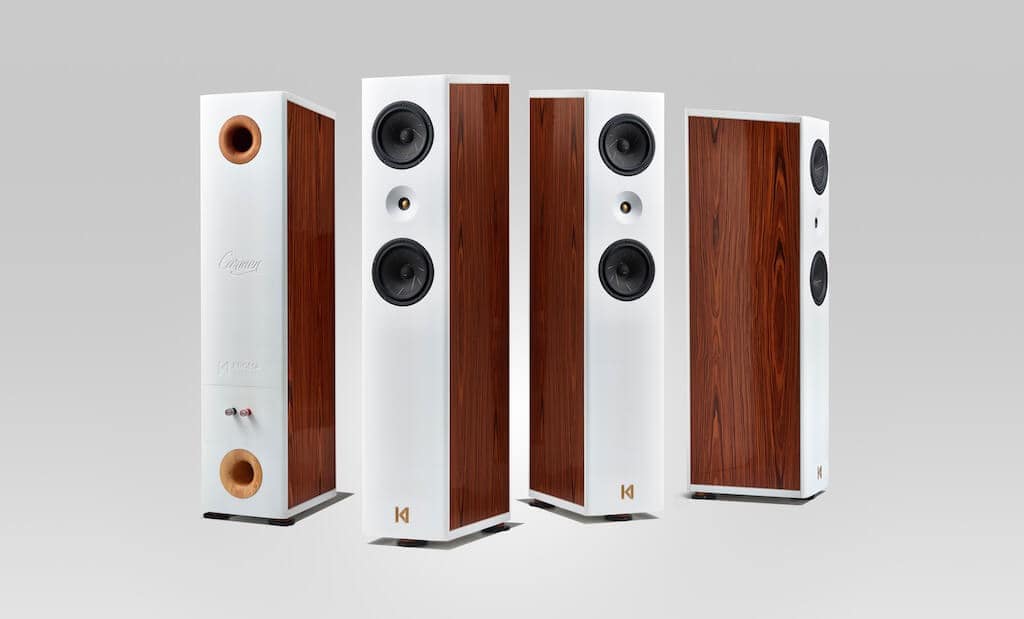LOUDSPEAKER REVIEWS, PASSIVE SPEAKERS REVIEWS
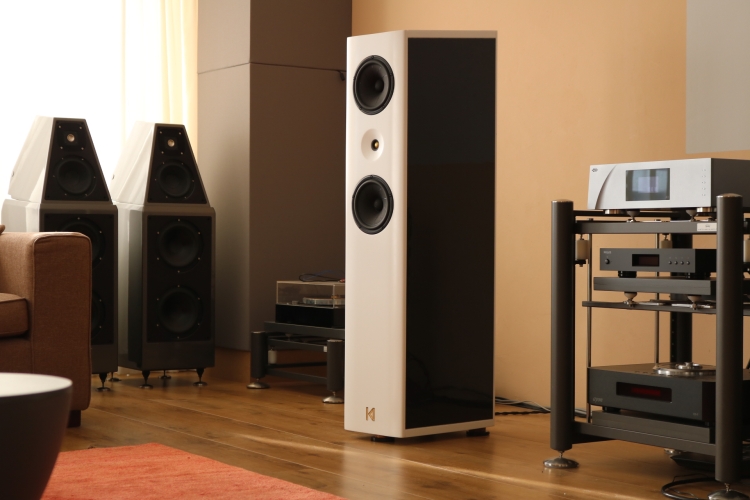
Company
When planning my trip to the EnoSound show in Bilbao early in 2018, Cayetano Castellano, Manager of Artesania and international representative as well as organizer of the EnoSound shows, revealed to me that he became co-owner and export manager for a new brand of high-end Spanish loudspeakers by the name of Kroma Audio. He said that they were really something special and that they would be one of the highlights of the upcoming EnoSound show.
The creators of the Kroma Audio products are Miguel Castro and Javier Millán. Miguel is the designer of the cabinets and Javier designs the crossovers and the fine-tuning is done together during long listening sessions because they believe that our ears are still the best adjustment tools. I have met these gentlemen several times and they are always very friendly and also extremely modest.
Indeed when I first heard these speakers, I noted some qualities that were really outstanding but because the rooms were far from perfect, I could not hear them in their full glory at that time. It wasn’t until after the guys gave an overwhelming demo later that year in Munich as part of the HiFi Deluxe show that I could hear that these speakers truly are world-class. Clearly, I wasn’t alone in thinking this as the orders rolled in and before they knew it Kroma Audio had representation in 10 countries!
This collaboration turned out to be advantageous for all involved: Miguel developed the new Organic Line for Artesania and Cayetano has enabled new business development for Kroma Audio, allowing them to grow from an accessories manufacturer to an important player on the loudspeaker market.
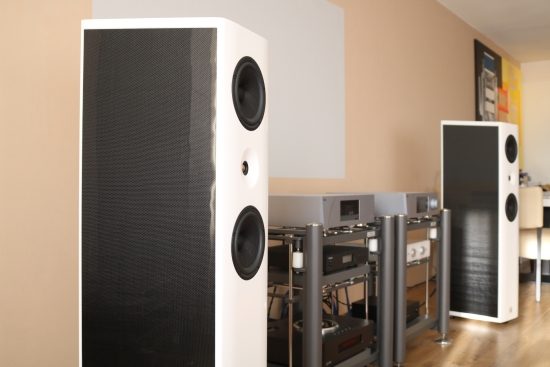
Company philosophy
Kroma Audio was created out of a desire to combine the highest level of High Fidelity with the naturalness and realism of a live performance. According to Kroma Audio, there are too many loudspeakers with artificial colorations that harm the natural timbres of the instruments and prevent the listener from forgetting that they are listening to a recording. It is their aim to suspend disbelief and to reproduce recorded music with an overwhelming, realistic live-performance-like fidelity.
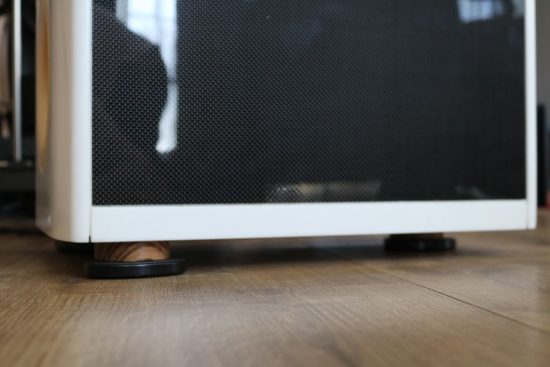
Techniques
The cabinets are fully made from white Krion, with carbon fiber inlays on the sides. The speakers are coupled to the ground via included specially manufactured feet made of non-metallic components. The speakers are made as much as possible using non-metal parts and this even extends to the screws with which the drivers are mounted, which are made of thermoplastic! Miguel told me that this is absolutely not only marketing but actually very important for the sound, and knowing how much difference different spikes and other coupling devices can make I certainly believe him.
The passive crossover, comprised of ultra high-quality components from Duelund, Mundorf and very special NOS components, is isolated in a hermetically separated chamber. The tweeter is made by Hiquphone, a relatively new company headed by the former designer of Scan-Speak drivers. The two Mid-woofers are Scan-Speak Revelator 6,5” made under Kroma Audio specifications. Nominal impedance is 8 ohms and combined with a 91dB sensitivity this makes for a very amplifier-friendly speaker: officially minimum recommended amplifier power is only 15W. The speakers weigh 100kg each and come standard in white Krion with Carbon Fiber but are also optionally available in true 24 Karat Gold Leaf finish.
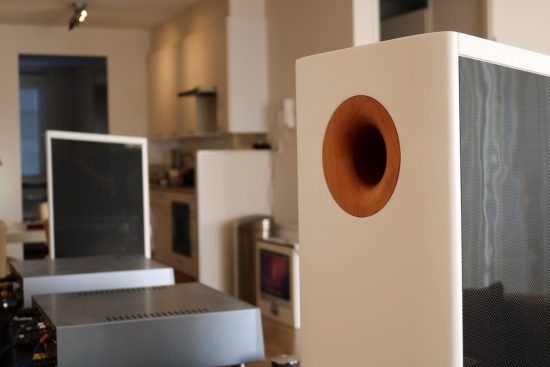
Tuning
Inside the Krion speaker cabinets, different kinds of wood are used in carefully selected places. Evident from the outside are the two bass-reflex ports, machined from solid wood and of a different wood sort for each port: cedar wood for the medium frequencies and spruce wood for the bass frequencies, with different thickness. According to Miguel, this is really important for the final performance and again I have absolutely no reason to doubt this. Finally, there are some small wood pieces in very critical places inside the cabinet to control the energy and to achieve the final part of the fine-tuning with the most natural tonality.
System Context
The setup in which these loudspeakers will be reviewed normally consists of the CH Precision C1 DAC/Streamer/Controller and A1 stereo amp, two music servers: the Melco N1ZH and the Antipodes EX and Wilson Audio Watt/Puppy 8 speakers. For this review, the Wilsons were moved out of sight near the left wall, with their inputs shorted. As a starting point, the Kroma Audio Carmens were set up in the exact same positions as the Wilsons were.
Speaker cables are the Jorma no.3 and analog interlinks the Cardas Clear XLR. All power cables are Belden 19364 with Oyaide 004 IECs, except for the ones for the power amps which in this case both used Belden cables with the warmer sounding Oyaide 079 IECs. I also tried Transparent Super Gen 5 and AudioQuest Water cinch interlinks and the CH Precision Balanced Link XLR cables and while all had their specific benefits I found the balance best with the Cardas Clear XLR. See the Zanden review for a detailed report of the relative differences between these cables.
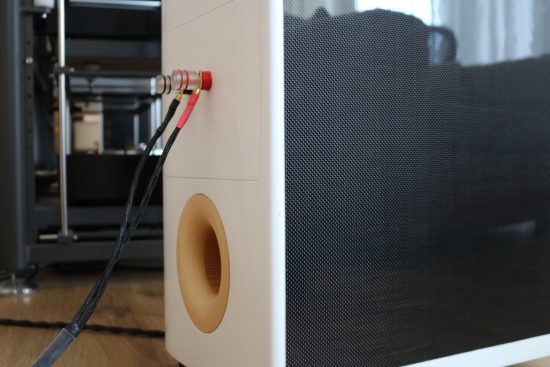
Preparations
Ben van Leliveld and Peter Chattelin delivered the speakers together with a Zanden 3100 preamp and Zanden 8120 power amp and they helped unpack and set up. This was no superfluous luxury, as these speakers are very heavy. They come in very sturdy and luxurious flight cases with embedded wheels so they can be transported by a single person with ease but the unpacking should really not be undertaken without help. Maybe two persons could have done the job but I was glad that both Peter and Ben were here to help. When the case was upright with its lid removed, one person held the case while two others wiggled the speaker out of its enclosure. Once the speakers are set up, they move about very easily on my laminate floor and moving them around on carpeting should also be easy, as long as their feet are added only after the speakers are in their final positions.
When all was connected up, Ben made only very minor adjustments to the speakers’ positions and pretty soon we were good to go. To start off, first, we listened to the Carmens using the CH Precision A1 amplifier. The Carmens are very easy to drive and sound much more controlled than the Wilsons and so I found that the A1 could be used best with its feedback adjustment control at its lowest setting, meaning zero global feedback and only local feedback. For the most articulate and precise bass I found that a setting of 20% was ideal but on balance, for the most pleasing overall presentation with a good balance between precision and organic flow, I preferred the zero percent setting.
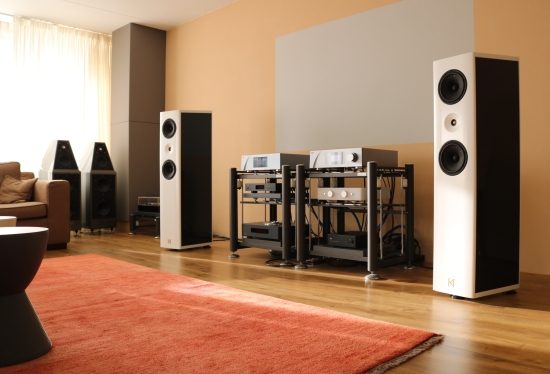
Listening – CH Precision A1
These speakers have superb bass. They are exceptionally linear and even-handed, much more so than my Wilson WP8’s. By comparison, the latter are a little bumpy, in spite of exhaustive room treatment. I’m sure that the Wilsons can have a perfectly flat output but perhaps only in a perfect room. The Kroma’s, however, simply perform sublimely in the same positions as the Wilsons. They reach as low as the Wilsons do, but because they are so accurate, they may not give this impression until you play a track with truly deep bass. These speakers do not add any heft to create a feeling of fullness, they simply reproduce what is on the recording. All the bass notes come out with perfect articulation and equal pressure. Regular readers may have noted how I tend to emphasize the importance of bass quality. I am admittedly a “Grundton-Mensch”, in other words, I have a preference for the fundamentals of music, more so than for the overtones, although I really couldn’t choose between the two as both are important. It is the bass, however, that forms the foundation of the music. You can have superb communicative powers in the midrange but if the bass can’t keep up, the combined sound will still be slow and non-realistic. It is the bass where the rhythm originates. For me, bass needs to be articulate, fast, dynamic and reach deep, too. Alas, all too often, depth is achieved at the expense of many other aspects, or vice versa. I don’t know how they do it, but the Kroma Carmen simply does it all.
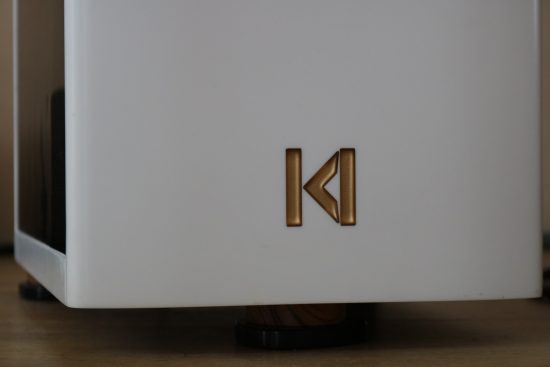
These speakers are also extremely precise, startlingly dynamic and vibrant and utterly lifelike. This is especially evident in the midrange but that area does not stand on its own. Midrange sounds have their fundamentals in the bass and although I’m sure that the mid/treble driver is something special, it truly is the incredible coherence with which the three drivers operate that makes these speakers’ midrange stand out. Regardless of their high precision, the Carmens never sound clean or cool. Their enclosure may be resonance-free but they sure sound richly colorful and full of vibrant life.
Piano and vocals sound utterly realistic, even more so than with the Wilsons. From the very first notes of any instrument, you instantly suspend your disbelief and succumb to the music. This is an aspect that literally everyone who visited picks up on – from ribbon-die-hards to small-speaker convicts to music lovers who have no ties with high end whatsoever. All it takes is three piano notes to convince.
The treble is also superb, not by standing out in any one aspect but because of the complete absence of any detractors. Like the bass, it is utterly linear. There is no harshness or edge nor any softening or blurring and there is certainly no dampening of dynamics but absolutely also never any edge or peakiness. Off-axis listening turned out to be another strong area, the speakers sounding extremely even, regardless of where you are seated. Even right next to the speakers, the output is still very linear. They are not ribbon-like in that they do not sound super-airy or super-refined but on the other hand they have incredible resolution and refinement, making me realize that the typical ribbon aspects that I used to chase after for so long may be nice to have but don’t have so much to do with accuracy or relaying the musical message.
I mentioned their coherence – I’m really not exaggerating when I say that it is as if the speakers’ three drivers work as a single driver. Whenever these speakers play, I find my foot tapping, always! They even make the Wilsons, one of the most coherent systems that I have heard so far, seem a little rough around the drivers’ transition areas. The Wilsons have great PRaT and they sound very fast indeed but they’re just not as linear as the Carmens.
There is absolutely no perceptible crossover between the drivers, no phase issues and no highlighting of any frequency range. All 3 drivers simply operate in utter unison. This makes for a very fast sound and combined with their high efficiency and linear impedance this also means that you don’t necessarily need to partner them with the fastest, most dynamic or most powerful amplifiers.

Listening – Zanden 8120
I was already prepped for the Zanden experience after having heard the Zanden/Kroma combination at the last Xfi audio show but in the context of my own listening environment, it can always be a little different. Although the Carmens have a nominal 8-ohm impedance and it would seem obvious to use the 8-ohm taps on the Zanden 8120 (as Ben also recommended), I felt compelled to experiment with this nonetheless. While the 4-ohm taps may work well for people who prefer a more relaxed and more romantic touch, I feel that those 8-ohm taps provide a more powerful, more transparent and more articulate delivery while still being superbly emotionally involving. The 8-ohm tap was clearly the technically correct option and also the one that I preferred.
So far, having listened with the CH Precision A1, I was already in awe with the Carmens’ performance but with the Zanden 8120, the Carmens stepped up the game even further. The CH Precision is extremely neutral (hey, it’s Swiss!) and also extremely fast and while it worked beautifully, technically perfect and with all the above mentions disbelief-suspending abilities, the Zanden 8120 tube amplifier turned out to retain nearly all of the A1’s the technical excellence, while adding an even more emotionally engaging aspect, more so than probably any transistor amp can provide. It does this not with coloration or added thickness but by better fleshing out the sounds and projecting them more freely in a soundstage that is not only more room-filling but also better layered and more 3D and therefore, more involving. While it made the Carmens sound a little fuller and sweeter, and a tiny bit darker, the delivery was just as speedy, dynamic, and lively as the A1, and very articulate.
The Carmens are very efficient and as with many efficient speakers, there is less of a filter effect, less energy loss and so the quality of the recordings does become more critical. With the Carmens, dry recordings will also sound dry. You simply hear everything that is in the recording – unfiltered. Good recordings sound amazing and lesser recordings sound, well, less amazing, but never unlistenable. That’s a very important point: although these speakers are very revealing, they always make music in a coherent, upbeat and entertaining fashion, even with mediocre recordings. The spirit of the music always shines through. Naturally one can add some sweetness by adding a smooth-sounding analog preamp (as I used to prefer for the longest time) but this is not the route that I wanted to take with this system. I no longer use an analog preamp because the super-refined C1 doesn’t need this and because I want to hear precisely what the components and speakers are doing. I did carry out extensive experiments using Zanden 3100 and Audio Research Ref5preamps and a detailed report of this can be read in the Zanden review. Suffice to say that the Carmens perform absolutely splendidly either with or without a preamp in the chain. With one, they sound even more organic, with even more richly saturated textures while still being more dynamic than any other speakers I used, without a preamp, they sound most articulate and direct, most vibrant and so utterly lifelike dynamic that I was hooked from the very first seconds of listening.
My critical mind had been dormant for a while now but with the Zanden in place, it became virtually impossible to re-engage it. All I wanted was to listen to more music and the same happened with anyone who came to visit. It was a sure-fire setup, never failing to deliver a spine-tingling performance. I could have ended the review here but there are a couple more amplifiers that I should try with these speakers. Reluctantly shaking off the urge to simply revel in the music, I re-enabled the critical reviewer mode.

Audio Research Ref75 SE
The Ref75 SE is a long-standing favorite of mine. This amp sounds remarkably transparent and refined and very finely detailed and it can challenge my CH Precision A1 on these aspects. This amp’s Achilles heel is its bass, which can lack power, propulsion, and body depending on the speakers. With the Carmens, it actually has the best bass I heard from it so far and its free-flowing, yet pure, intimate and direct-coupled presentation works really well with the Carmens. In terms of timbre, resolution, and refinement the ARC performs similarly well as the Zanden and depending on the music played, the preference could be swung either way. The Zanden is considerably more sonorous and solid in the bass and it has more power, too. Perhaps partly because of this, rhythm, percussion instruments, and piano sounded best with this amp, while certain soulful arrangements could sound purer, more informative and more emotional, with the ARC.

PrimaLuna DiaLogue Premium
The PrimaLuna has a very modest power rating (only 25 watts in triode mode) but has a very solid power supply and beefy output transformers which in practice means that it never had any issues driving large speakers and the Carmens are no exception. With this amp, they sound bold and powerful, well-timed and with bass solidity and fullness approaching the Zanden in that aspect (not in others!), with strong dynamics and natural, convincing timbre. Sonority and power remain this amp’s strongest assets and it drives the Carmens with authority indeed but in this exalted company, the PrimaLuna lags behind in all other aspects, mainly resolution, refinement, and soundstage layering. It is just a bit too rough, painting with very broad strokes. Nevertheless, this very modestly priced amp deserves mention for still driving these speakers very well and sounding nicely upbeat and dynamic while doing it.

Ayon Scorpio
The Ayon Scorpio is on a visit for review, really only supplied, because the higher model up, the Spirit III, was not available on short notice. Not suspecting much I connected it and… I was flabbergasted! This amp sounds just as solid, sonorous, upbeat and dynamic as the PrimaLuna but much more transparent and much more refined. Also, it is faster and more articulate and has a natural, lifelike timbre to die for. It does all this and adds to it a purity and directness that reminded me of the Ayon Crossfire III SET-amp that I had on loan a while ago. With the Scorpio, the Carmens sound even purer and more direct-coupled and therefore more emotion-inducing than the Zanden, even if the latter is considerably smoother and more refined as well as more textured and more organic.

The Ayon is closer in sound to the Audio Research Ref75 SE and although that amp is also more refined, more fluid and airier, it lags behind the Ayon in terms of bass control and overall dynamics and slam. Some people may well find the Ayon a little bit too direct and they may prefer a warmer, gentler or smoother presentation but for me, the Scorpio provided the absolutely most lifelike experience that I have heard in these quarters. I already fell in love with the Carmens with the CH Precision A1, then fell even deeper in love when they were combined with the Zanden and absurdly enough, I like them even better with the Ayon. Now don’t get me wrong – I’m not saying that the Ayon Scorpio is the best amp bar none but out of all the amps that I tried with the Carmens, it does make my heart jump out most and so for me, in these circumstances, so far, it is ideal. The best part? Guess what the Scorpio retails for? Cough- 4.600 euro -cough. One has to wonder what the Ayon models higher up will achieve!

Perspective
In a direct comparison right after installing the Carmens, the Carmens sound slightly darker than the Wilsons but so very great in all other aspects that this was soon forgotten. The extra air that the Wilsons have was very welcome for me at the time because it made for a perfect transition from the Magnepans and Apogees (in terms of openness) that I had used for so many years. But after having listened to the Carmens for two weeks, I was to face a new transition period. Upon returning to the Wilsons, fortunately, I was not completely disappointed. They still are great speakers. But I would not have guessed that I would now find them to sound a little bit too bright. Where the Carmens are supremely linear from the lowest lows to the highest highs with no discernible driver takeover points, I could now hear the different characters of the three drivers in the Wilsons. There was now some coloration in the midrange and some spot-lighting in the treble, and the bass was nice and deep and not colored but less articulate and not as dynamically propulsive. Dynamically, the Wilsons have always been great but also on this aspect, too, I had to admit that the Carmens performed even better. What can I say? One can always do better, right? Well, at this very moment I cannot think of any speakers that have impressed me more than these Carmens, except for perhaps, you guessed it: the Kroma Audio Elektra.

Conclusion
The Kroma Audio Carmens are truly universal speakers: they excel with acoustical instruments, percussion, and vocals but they sound equally impressive with Christina Aguilera and Lady GaGa. Azymuth’s samba doido (jazz-samba-fusion) sounds absolutely infectious and even gritty Dub-techno is delivered precisely as it should. They always turn in a dynamic, vibrant and lifelike performance and they never get confused, no matter the complexity or the amount of subterranean bass present in the recording. Their bass is not only fast, well-timed and utterly coherent, it is also supremely linear from the lowest to the highest notes, plumbing to subwoofer-like depths and remaining ruler-like linear right up into their upper treble.
While I found the Carmens to match particularly well with the Zanden 8210 power amp, they always have superb communication powers, they simply always sound timbrally wholly convincing and never fail to make your foot tap. They are truly great all around but they excel in linearity, purity, coherence, organic textures and natural timbre. These aspects stand out with the slightly smooth Zanden but also with the very neutral CH Precision A1, the open and airy Audio Research Ref75 SE, the pure and direct-coupled Ayon Scorpio and even the very affordable PrimaLuna DiaLogue Premium. All of these amps drive the Carmens perfectly, while ticking more or less audiophile boxes but always producing pure, vibrant and involving music. It seems that they work with pretty much any amplifier.
Don’t take only my word for it – each and every person who visited to hear this setup commented on how utterly realistic and totally engaging they sound. Several of my audio friends commented that this is the absolute best sound they heard, period – either in my room or elsewhere. Many of them would trade their systems for this, myself included. Even JW, a die-hard ribbon-fanatic, agrees that the Kroma Audio Carmens are exemplary. They are technically superb and highly revealing. They tick each and every one of the audiophile boxes but more importantly they never fail to make pure, soul-stirring music in its purest form. Yes, they cost an arm and a leg. But if you can afford them, these may be the last speakers you need. Forget about technicalities, paraphrasing how a Rolls-Royce dealer might respond to being asked how much power the engine has: “more than enough, sir”. This is my way of saying not to worry about the technical aspects, they do all that and more, so just start enjoying your collection!
http://www.hifi-advice.com/
Available from: Chattelin Audio Systems
Distributor for the Netherlands: Harmony Audio Import
Manufacturer’s website: Kroma Audio

